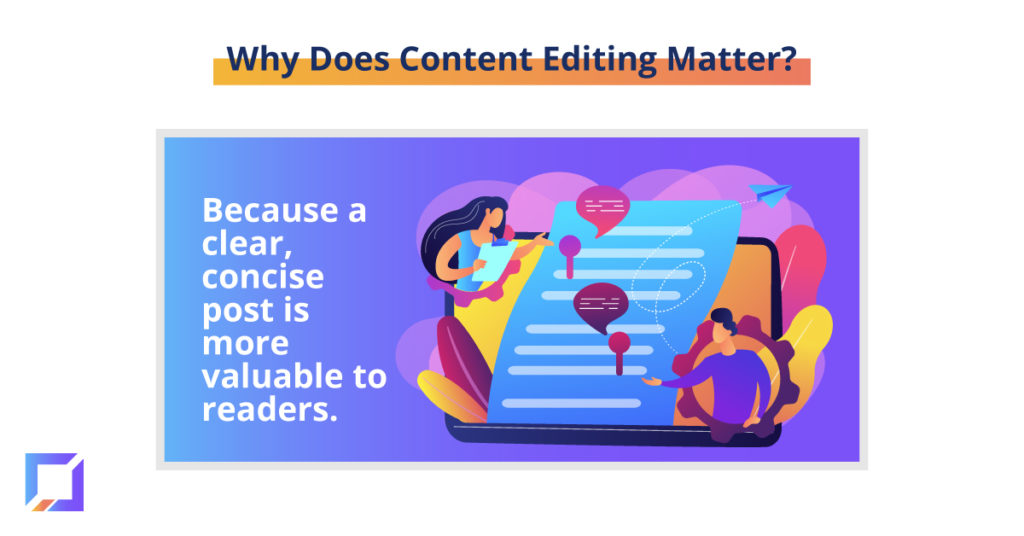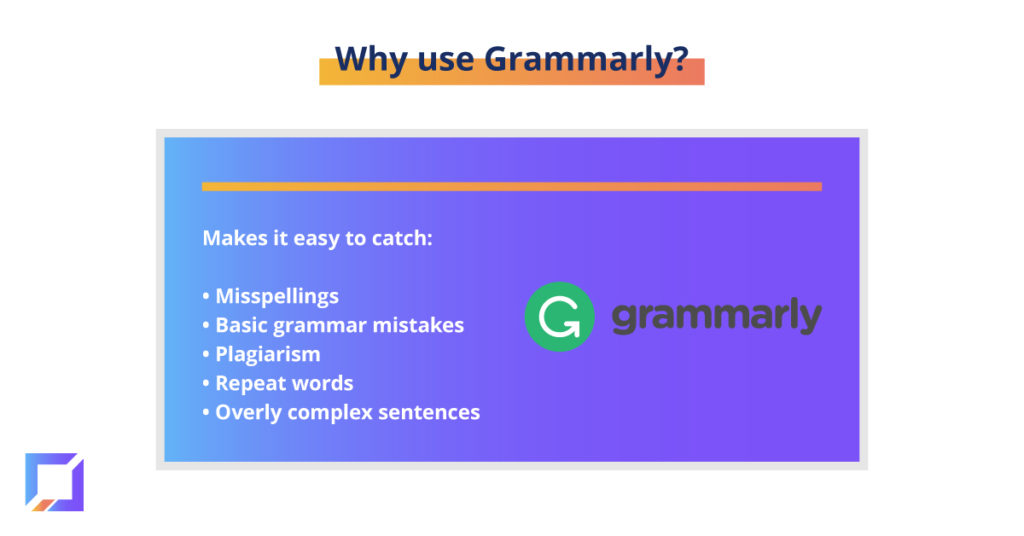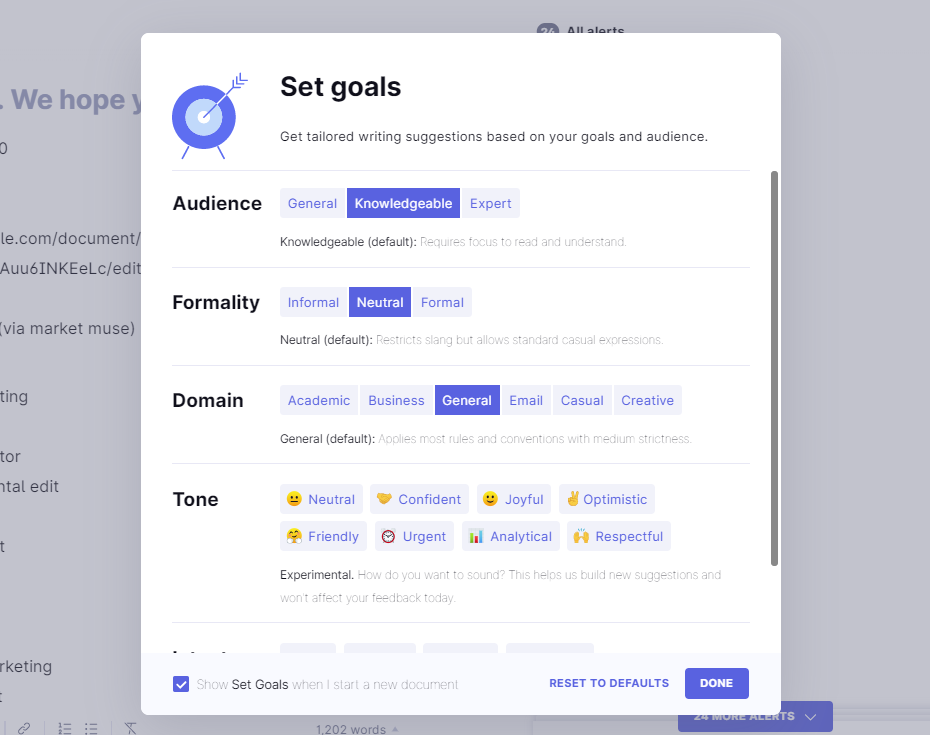Whether you are building a SaaS business or selling handmade coffee cozies, there’s one key element you need to succeed online — content.
Great content educates, informs, and (most importantly) sells.
But creating great content that stands out is a challenge.
For starters, content creation is time-consuming. In fact, the average blog post takes 3 hours and 57 minutes to write.
You might not have that much time to dedicate to writing. Or, you might be a terrible writer. Maybe you hate writing.
If writing isn’t your cup of tea, you might consider hiring out the work.
But it gets expensive to hire a separate writer, content editor, copy editor, and designer to make the content look good.
So, what’s the solution?
A solid grasp on content editing will help you write better content — or edit the content you hire out — so you publish only the highest quality content.
Which is exactly what we are going to cover today.
But first, let’s talk about why content editing matters.
Scale insightful marketing content across the web.
We help you grow through expertise, strategy, and the best content on the web.
Why Is Content Editing So Important?

Content editing is a stage of the editing process that aims to check written content for effective, cohesive, and understandable arguments. It also looks at grammar issues like misspellings, comma splices, and incorrect word choice.
Content editing is critical to the online publishing process because poor content quality with typos and grammatical errors will demolish any trust users have in your content — and your brand.
Our content marketing agency produces over 300+ articles/month, so we use Grammarly Premium on a daily basis. Similar to our MasterClass review, the value you get from using Grammarly is well worth the cost.
Poorly formulated arguments also make it harder for you to make your point and convince readers to take whatever action you’d like them to take.
For example, are you likely to buy an expensive training course when the website content and landing page are riddled with misspellings?
Probably not.
Compared to outbound marketing efforts, content marketing earns three times more leads — and costs 62% less. But, if you want to get the most out of your content marketing efforts, your content needs to be high quality.
Part of high-quality content lies in doing keyword research and optimizing using structural elements like H2 and H3 headings, internal links, and including a variety of long-tail keywords.
But content optimization is just the start. You also need to make sure your content is easy to read and makes sense — which is where content editing comes into play.
What is the difference between content editing and developmental editing?
Developmental editing is a phrase usually used in book publishing that refers to an in-depth edit of an entire piece of content to make sure your plot or arguments are strong and sound. Content editing generally includes both proofreading and some light developmental editing.
Developmental editing is not generally used when talking about brand-related content, such as blog posts, white papers, etc.
Step 1: Get it Written, Then Get it Right

Writing is an art — even when you are writing for a brand, there’s a certain amount of creativity required to create high-quality content that connects with readers.
A lot of writers get caught up in making sure every sentence is perfect or looking for just the right example to prove a point.
As a writer, trying to make every sentence perfect is going to slow you down. You’ll never even get to the editing part because you’ll be so focused on making sure that each sentence is the best sentence ever.
However, if you need a bit of help to start writing your first sentences, you can use a rewording tool so that you can choose the best tone and structure for your ideas.
Here’s the secret to writing well — you have to be willing to write poorly.
Which might feel a bit counter-intuitive, I know.
Here’s the deal, though — if you spend five hours writing the first draft of a 1,000-word blog post, you’ll be frustrated and prone to procrastination.
Instead, start with a solid outline and just get the content written.
Turn off your internal “editor voice” and just get your main ideas down. Then, go back and make it better in the editing stage — which is exactly what this post will show you how to do.
Step 2: Set Your Writing Aside For a Full Day
Once you have a solid first draft, set your writing aside for a full day, and work on something else.
I know, you want to get this piece out as soon as possible — maybe you are on a deadline or just want to check a box off your to-do list.
Don’t rush through your content writing. Instead, take the time to set the piece aside for at least a few hours, if not a full day.
This will give you time to think of new points, better examples, and cleverer turns of phrase. Then you can take a look at your content with fresh eyes.
Here’s the deal — when you edit your own writing, you tend to see what you meant to write, rather than what is there.
Think about the last time you saw something you wished to see — a long lost friend in a crowd or a perfectly intact shell on a beach walk.
Our minds are highly efficient, which means your brain will often fill in missing information with what you expect to see. That is why it’s so difficult to notice when you’ve used the wrong word (i.e., “your” instead of “you’re”) in your own writing even when you know the difference.
Take, at minimum, a few hours away from your writing before going back to content edit — your writing will be better for it.
Step 3: Do a Structural Edit
Once you have a solid first draft down and have taken a few hours (or a day) away from the content, it’s time to take a hard look at your work with a structural edit.
Structural editing, which might also be called a developmental edit or line edit, is the most complex level of editing. This is the step where you focus on line editing and look for gaps in your writing and other errors that impact your overall argument.
As you read through, ask yourself these questions:
- Does your content flow from one step to the next in a logical fashion?
- Did you use transitions to move readers from one idea to the next?
- Did you repeat any phrases or points?
- Do you provide examples to help clarify complex ideas?
- Did you include images to break up the text and illustrate points?
- Did you back up statements with studies, reports, and facts?
Depending on the length of your content (and how many changes you need to make), this step in the editing process could take anywhere from half an hour to two or three hours.
Take your time and read through the post two or three times if you need to — this is one of the most critical stages in the editing process, so you want to take your time to get it right.
Step 4: Use a Grammar Tool to Check for Common Errors, Then Copy Edit

Whether you are editing your own content or a piece someone else has written, I can’t recommend using a grammar tool enough.
I know, I know.
Some people think it’s cheating or grammar tools are all terrible. It’s true that grammar tools aren’t perfect, but they will highlight mistakes you might miss on your own.
Grammarly, my grammar tool of choice, checks for common errors, including misspellings, run-on sentences, and misused words.
Our content marketing agency produces over 300+ articles/month, so we use Grammarly Premium on a daily basis.
You can even check for tone, using their goal setting.

This nifty tool allows you to tell Grammarly what tone you are going for, so it can make suggestions to help your content better fit your target audience.
No, it’s not perfect. But it will highlight areas that might need a bit more work. For example, Grammarly highlighted this section as being a sentence fragment:

It isn’t — Grammarly doesn’t recognize it’s own brand name as a noun, apparently. But it is a bit clunky, so I might take a second look to see if I can smooth the sentence out and make it easier to read.
The paid version of Grammarly also features a plagiarism checker, which can help ensure you don’t publish duplicate content, even by accident.
Just remember that Grammarly isn’t a professional editor — it’s a tool you can use to produce better writing.
Once you’ve used your grammar tool, go back through and copy edit, looking for misspelled words, incorrect conjugations, punctuation, and repeat words.
Step 5: Review Your Content’s Formatting

The best-written content won’t drive traffic or generate leads if no one ever reads it. So, how do you make sure people can find your content and actually read it?
By using formatting elements that take online reader behavior into consideration.
Think about the last time you read an article online — did you sit down in a comfy chair, turn on a light, and focus your attention fully on the article? Probably not.
Most of us read online content while we wait in line at the grocery store, get our hair cut, or during commercials of our favorite television show.
Online readers are easily distracted.
You need to make sure your content grabs their attention quickly and doesn’t scare them away with huge blocks of text.
Here are a few formatting features to include in your content creation process:
- Use H2 and H3 headings to break up the text and help your main points stand out.
- Include two to three internal links to keep readers on your website and offer more detail on related topics.
- Include two to three external links to reputable sources where readers can learn more.
- Add an image every 200 to 300 words — but make them useful and high quality. Diagrams, charts, and illustrated statistics help break up the text and highlight important points. Avoid stock photos as much as possible. You can use a free online photo editor to ensure they are properly edited.
- Include bullet points, numbered lists, and charts to make longer ideas easier to comprehend.
- Use pull quotes, bold text, and italics to highlight important ideas.
- Include a strong call to action that tells readers what to do next — download a white paper on a related topic, sign up for your email newsletter, or ask a question in the comment section.
This step is also the time to add SEO elements to help your content rank better in the search engines, such as alt tags and meta descriptions.
TOP TIP: To make it super simple to ensure that what you’ve formatted in Google Docs is reflected in your CMS, check out Wordable’s free migration tool. It makes transferring content from Google Docs into a CMS like WordPress as easy as the push of a button.
Step 6: The Final Read Through
Once you’ve done all of the above, it is time for the final proofreading.
By now all the major mistakes should be fixed, but there are likely a few mistakes that slid past your first pass. Plus, you may have added errors while making structural changes or adding formatting elements.
Sit down, turn off your email, silence your stat notifications, and read your entire post through from start to finish.
Don’t let yourself get distracted by other tasks on your plate.
If you’re prone to distraction, try a tool like Tomato Timer and force yourself to stay focused for at least 24 minutes.
Look for grammar errors, arguments that aren’t as strong as they should be, broken links, missing punctuation, and so forth.
Highlight any changes you make — and then re-read those paragraphs to make sure you didn’t add additional errors.
Once you’re done, run the whole thing through Grammarly or your grammar tool of choice for one last, final check.
And, just like that, you’re done. It’s time to hit publish.
Conclusion
Content editing is, by far, the most critical stage in content production.
Editing is what turns ideas into arguments and, hopefully, audience members into customers. But editing doesn’t come naturally to everyone — and editing your own work is a challenge.
Here’s one, final, piece of advice: edit your content and then publish it. Don’t get caught up in editing over and over again.
You will always find a sentence that could be a bit stronger or an awkward phrase that could be tweaked. Aim to create great content, but don’t let the editing process prevent you from hitting ‘publish.’


